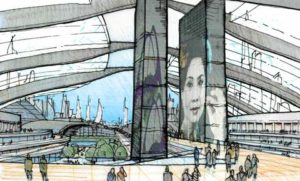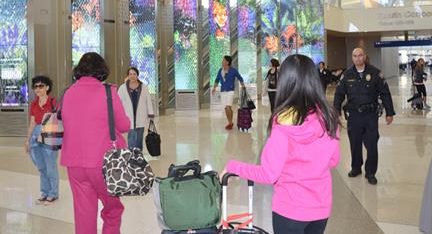The Golden Age of Airports
Right now – at the very moment you’re reading this page – a million people are in the air. They are among the six billion travelers the Airports Council International estimates will board commercial aircraft for flights both here and abroad this year. Economies may stumble and governments fall but the demand for air transport soars ever upward. According to the International Air Transport Association (IATA), worldwide passenger traffic for 2015 is up 8% over last year, with Middle Eastern airlines enjoying an 18% increase. By 2016, the annual number of airline passengers could surpass the world’s present population of 7.1 billion people.

Denver architect Curtis Fentress believes future airports will be massive, open meeting places in addition to inter modal transport hubs
Airlines not only are flying more people, they are making more money. The 22,150 commercial airplanes flying in and between Asia, North America and Europe are virtually full. Last year, America’s airlines filled an average of 83.1% of their seats. IATA predicts that airlines worldwide are on track to record $18.7 billion in profits this year thanks to increased load factors, reduced competition, a growing global economy and the fact that corporate travel managers once again are buying premium class tickets.
No aviation market is growing faster than Asia. A decade ago, China’s 35 carriers had just over 200 western built aircraft. Today, 46 Chinese airlines fly more than 2,000 aircraft, most of which are among the newest in the world. GBTA research indicates that China’s business travel spending will jump 17% this year and surpass the U.S. as the world’s largest business travel market by 2016. Says IATA CEO Tony Tyler: “Predicting the quadrupling of Asia’s aviation industry over the next two decades would most likely be a conservative estimate.”
Airline industry profits eventually may pay for increased inflight amenities, but for the moment much of the revenue is being invested in new airports and terminal expansions. With the demand for air travel in the U.S. projected to grow by as much as 400 million passengers annually within 20 years, the need for larger, more efficient airports is critical.
“The gap between the busiest day of the year and the average day is shrinking,” says Roger Dow, president of the U.S. Travel Association. “Many of our top airports already are experiencing a Thanksgiving-like day once a week. Within five years they will have two days like it each week. In 15 years there will be three days like it.”
In Asia the potential for gridlock is even worse. Jakarta’s Soekarno Hatta airport already is operating at twice its design capacity. With 65 arrivals and departures every 60 minutes, Hong Kong International Airport is close to its legal peak of 68 movements an hour. China plans to build 100 new airports over the coming decade, but even that may not be enough since the country’s air traffic doubles every six years.
No structures better captured the spirit of the American Century than airports. When it opened in 1960, Idlewild’s Pan Am Worldport embodied the Space Age with a circular roof that projected outward like a hovering flying saucer. TWA asked Finnish American architect Ero Saarinen to “capture the spirit of flight” and in 1962 his concrete and glass Trans World Flight Center in New York did exactly that with curvilinear walls and a roof shaped like an eagle in flight. Unfortunately, the polish, glamor and optimism of 1960’s airports soon succumbed to bureaucratic inflexibility, deregulation and the need to funnel more people into larger planes. Lamented British author Dennis Potter in a 1978 letter to The Sunday Times: “I did not fully understand the dread term ‘terminal illness’ until I saw Heathrow for myself.”

Drones and gyrocopters but no Jetsons
By the mid 1970s, airports deemed futuristic a decade before were struggling to meet new demands. The introduction of Boeing’s 747 in 1970 meant gates had to be converted to handle larger planes carrying more passengers. Security checkpoints claimed most of the remaining space because 66 planes were hijacked to Cuba between 1969 and 1972. Airports conceived as centers of romance and imagination became generic boxes that could be hosed down and squeegeed at night.
Today, after a decade of retrenchment and consolidation, airlines are spending money on airports in anticipation of exponential growth in travel. Indeed, we may be entering a golden age of airports where international hubs once again feature fine dining, cocktail terraces and facilities where business travelers can be productive before and between flights.
Delta Airlines is spending $2 billion to improve all of its New York area terminals with the bulk of the money – $1.4 billion – going to JFK’s Terminal 4. Additional gates, an expanded baggage claim, a 24,000-sq. ft. Sky Club and dramatic rooftop deck are drawing most of the attention. But a larger, more efficient TSA security area may provide the biggest return on investment.
“We hope passengers will go to the airport early and pass quickly through security so they can enjoy the airport experience,” says Chuck Imhoff, Delta vice-president for New York sales. “We’re creating a package based on speed and efficiency that appeals to corporate customers and other high-end users. The Delta area at LaGuardia has ten different dining options. It looks like you’re walking down a street in Manhattan.”
Recent technological upgrades allow airlines to sell products directly to passengers at booking, at check-in and on mobile phones while a passenger is walking to the gate. Delta recently gave its flight attendants wireless devices allowing them to sell last minute upgrades to seats with more legroom. “We have massive amounts of data,” says Delta CEO Richard Anderson. “We know who you are. We know what your history has been on the airline. We can customize our offerings.”
Some airlines are developing methodologies that allow them to track passengers throughout the airport. If somebody clears security hours before their flight, he might receive a discounted day pass to the airline’s lounge on his smart phone.
Research shows that a person with two hours to kill between flights is two and a half times more likely to make an unintended purchase than he would if simply walking through a shopping mall. But what do people really want from an airport? Responding to passenger feedback, a few airports have set aside space for cell-sized sleeping rooms, cinemas, green outdoor areas and standing holograms that explain TSA rules to travelers awaiting inspection. But a survey of 2,100 travelers conducted last year by FlightView, a Massachusetts company providing free day-of-travel information to passengers with mobile devices, revealed that passengers put a premium on practicality.
“Travelers want to be able to use electronic devices that allow them to be productive professionally,” says FlightView CEO Mike Benjamin. “This means charging stations for electronics plus free, reliable and secure WiFi accessibility from anywhere in the airport.”
Executives passing through Denver International, the nation’s fifth busiest airport, enjoy free internet access, battery charging stations at every gate and the ability to make free domestic and international VOIP phone calls on special phones positioned about the airport. Digital advertising appearing on 17-inch LCD screens attached to the phones subsidizes the cost of the calls.
It’s often difficult to separate a city’s economy from the popularity of its airport. Denver International is Colorado’s primary economic engine, generating more than $22 billion for the region. Delta’s two New York terminals contribute $13 billion to the GDP of the State of New York. In Los Angeles, which has the world’s sixth busiest airport, LAX generates 295,000 jobs with labor income of nearly $14 billion and an economic output in excess of $40 billion.
Location. Location. Location. It means everything in real estate. But an airport can lose business if it grows complacent. LAX thought growth was a given until June 2009 when an architecture magazine called Dwell proclaimed it the worst airport in the U.S. “It is best described as a collection of drab terminals connected by a traffic jam,” is how the publication characterized America’s gateway to Asia. “The scene ought to be inspired and dynamic, rather than stressful and depressing.”
Los Angeles, of course, is a show business town that doesn’t worry much about one bad review. But people running the city started to worry when Qantas gave LA’s mayor an ultimatum: Do something about LAX or we’re moving to San Francisco. It didn’t help that SFO at the time was running ads in aviation magazines that asked, Why not fly into the U.S. through a good airport?
With billions of dollars at stake, Los Angeles called in Denver architect Curtis Fentress to redesign LA’s international terminal. Fentress had designed airports in Denver, San Jose, Raleigh-Durham, Seattle and Incheon, Korea, and was known for his use of sustainable building materials, soaring Great Halls and designs reflective of the region the airport served.
Denver’s International Airport had an iconic fabric roof with dramatic, soaring peaks evocative of the nearby Rocky Mountains. San Jose’s airport incorporated a dappled roof that made natural light seem as if it were filtered through a forest canopy. Raleigh-Durham’s design paid tribute to North Carolina’s Piedmont region by using enormous wood trusses each weighing 34 tons to span airy, column-free ticketing areas. Inspired by Pike Place Market, Fentress transformed Seattle’s harried transit lounge into a town square full of shops selling wine, smoked fish and other items indigenous to the Pacific Northwest. “A trip to this airport is really fun,” noted Sunset magazine. “In this tranquil, park-like atrium you might even hope for a flight delay.”

LA’s improved Tom Bradley International Terminal prevented airlines from moving flight operations to SFO
In Los Angeles, Fentress was given a budget of $1.9 billion and told to modernize a terminal that served only microwaved burritos after midnight and often required incoming passengers to spend two hours passing through immigration and customs. “An airport is all about passenger experience,” Says Fentress. “Successful airports are interesting and exciting.”
Though opened officially in September 2013, LA’s Tom Bradley International Terminal remains a work in progress. But there’s no denying that it is more reflective of the city it serves. Once through security passengers enter a soaring 100,000-sq. ft. Great Hall with ceilings as high as ten stories. Clerestories beneath a wave-like roof let natural light filter through silkscreened glass. Large digital screens touting local attractions rise above shops and restaurants serving everything from steak to pizza.
“LA is about food, entertainment, shopping and the environment,” says Fentress. “It’s also a media town with incredible weather. Should the terminal reflect the city’s film industry or its cultural diversity? In the end, we invited community representatives, business leaders and airline executives to focus groups before arriving at the final design.”
The most meaningful improvement, however, is the increase of passport control stations from 16 to 40 with additional space set aside so that the number of immigration checkpoints can double, if needed.
The increase in global aviation is best seen at hub airports. Dubai International is now the third busiest airport in the world with 150 airlines serving more than 260 destinations across six continents. Passenger capacity is projected to grow from 75 million today to nearly 100 million by 2020. Last year, Jordan’s Queen Alia Airport outside Amman opened a new $750 million terminal that tripled its passenger capacity. Later this year, Jeddah’s King Abdulaziz International Airport fill finish augmenting its Hajj Terminal with three new terminals designed to increase the airport’s capacity to 80 million a year. This April Saudi Airlines began flying three nonstop a week between LAX and Jeddah. “California is the world’s eighth largest economy and is home to more than a million Muslims,” explains Jonathan Pansacola, Saudia’s marketing manager for the Americas. “Corporate business travelers, Saudi students studying in California and inbound tourists will fill our planes.”
In the past, airports were perceived as gateways for the transportation of goods and people from one region to another. In several countries, however, this historic model is being replaced by the airport city, a mixed use development in which the airport anchors an adjacent city that has hotels, office towers free trade zones and entertainment areas just beyond the airport fence.
Hong Kong International Airport for instance hosts more than 30 high-end designer clothing shops. Singapore’s Changi offers cinemas, saunas and a tropical butterfly forest, while Las Vegas McCarran has a museum and Amsterdam’s Schiphol a Dutch Masters art gallery.

Incheon International sell Korean culture
South Korea’s Incheon International Airport is perhaps the first to merit the title aerotropolis. Built on a man-made island in the Yellow Sea, Incheon abuts on New Songdo City, a newly-built, stand alone city where residents can live, work and play – when not boarding airplanes or going to work at the airport.
Officially, Incheon opened in 2001 but in reality the $13 billion airport remains under construction with only three of the five runways complete. Unlike American airports where amenities are designed to fill two to three hours of time, Incheon is prepared to amuse people for a day or longer. Three times a day actors garbed in Joseon Dynasty (1320 – 1910) regalia reenact the “Walk of the Royal Family” in the departure and transit areas. Not into history? Then head to the fourth floor of the passenger where there’s an authentic Korean Cultural Street with themed shops and restaurants. In all, the Incheon airport hosts more than 5,000 cultural events a year, but if you only have 90 minutes between flights, better stick with the massage parlors and free shower facilities in the transit lounge.
But when it comes to airport cities no place equals Singapore’s Changi Airport. “We prefer to call Changi Airport a destination for travelers from all over the world as well as for local Singaporeans,” says Lim Ching Kiat, the airport’s Senior Vice President for the Changi Airport Group. “There are passengers who might like a fine meal or a good sleep before a flight. To meet these varied needs we have 120 food and beverage outlets ranging from food courts serving Singaporean food to bistros and bars.”
More than 32,000 people work at Changi and often it seems their goal is to make sure you never have to go into Singapore. There’s a cactus garden atop Terminal 1 that rivals anything Arizona has to offer. There’s an orchid garden and koi pond – both air conditioned for your pleasure in Terminal 2 next to a sunflower garden and Entertainment Deck that offers beach volleyball, video bowling and soccer plus a movie theater and Bossa Nova lounge.
Changi soon will launch Project Jewel, a 1.4 million sq. ft. glass and steel pleasure dome connected to the airport’s four existing terminals. Dominated by a fresh water waterfall, swimming pools and other food and beverage facilities interspersed amid an indoor tropical garden, Project Jewel aims to be a destination in itself.
“Passengers have a choice when it comes to how they travel and, if a stop-over is needed, where they transit,” adds Lim. “Changi hopes to stand apart from other airports by providing a personalized, stress-free experience.”![]()


